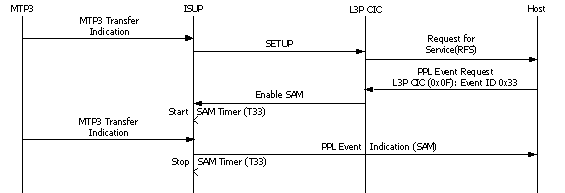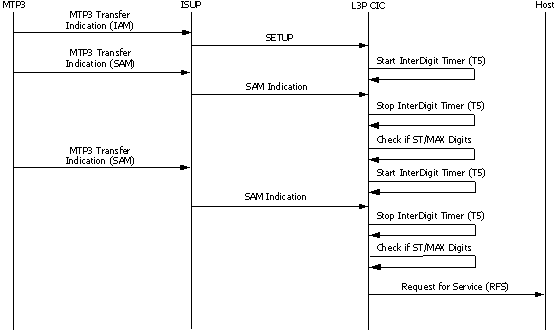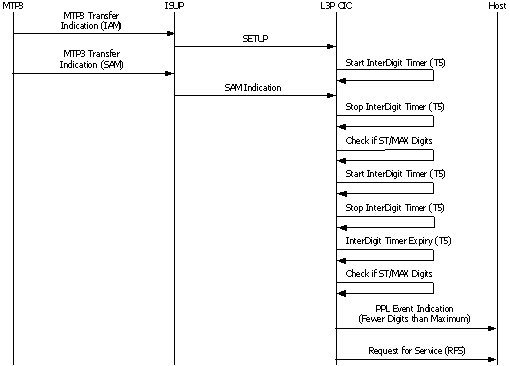
You are here: CSP Developer’s Guide: Common Channel Signaling > 4 SS7 Call Control for ISUP > Overlap Call Digit Collection

Overview
Overlap Call Digit Collection provides the capability for overlap calls to collect digits from multiple messages before forwarding them to the host, a capability normally reserved for En-bloc calls.
This feature supports the collection of digits received in a Subsequent Address Messages (SAM) and the inclusion of those digits in a single Request for Service (RFS) message sent to the host. Using this method, the RFS with Address Data is not sent to the host until the SETUP Initial Address Message (IAM) and all the SAMs have been received. Thus, the host is able to process an overlap call as though it were actually En-bloc.
The existing default method of digit collection, by contrast, sends an RFS with Address Digits and a partial Called Party number, followed by SAMs, which are represented as PPL Event Indications. The host has to wait for the additional digits to be processed before continuing its call setup.
This ITU-T variant provides the following expanded functionality:
• The call setup process is made more efficient.
• The number of API messages that must be exchanged between the switch and the host to set up a call are considerably reduced, which improves flow where there are large volumes of traffic.
• This ISUP enhancement is backward compatible with previous versions of ISUP.
See the call flows on the following pages for descriptions of existing and new digit collection and for inter-digit timer events.
The following configuration applies to the PPL information found in SS7 PPL Information:
• The host uses the following two configuration bytes to enable or disable this feature. Both must be enabled:
• Component 0x0012 (CPC), Config Byte 0xD2
• Component 0x000F (L3P CIC), Config Byte 0x30
• The host configures the maximum number of digits the CSP must receive before it sends the RFS message to the host using a configuration byte as well:
• Component 0x000F (L3P CIC), Config Byte 0x31 (default is 0x0a)
• The host configures the PPL Timer used to determine how long a SAM should be waited for before processing the RFS using the PPL Timer Configuration message
• Component 0x000F (L3P CIC), Timer ID 0x05
Successful Handling of SAM in the Existing Implementation

1. A SETUP request is received with an insufficient number of digits.
2. The host sends a PPL Request to L3P CIC to enable the SAM Timer (T33) and wait for SAM.
3. When SAM is received, the SAM Timer (T33) is stopped and a SAM PPL Event Indication is sent to the host.
Expiry of SAM Timer in the Existing Implementation

1. A SETUP request is received with an insufficient number of digits.
2. The host sends a PPL Request to L3P CIC to enable the SAM Timer (T33) and wait for SAM.
3. If SAM is not received and the SAM Timer (T33) expires, a Call Failure PPL Event Indication is sent to L3P CIC, which then sends a Clear message to the host.
Successful Handling of SAM in the New Implementation
This call flow shows how the collection of digits is handled in SAM after the new functionality has been added.

1. A SETUP request is received with an insufficient number of digits for successful call translation.
2. The InterDigit Timer (T5) is started to wait for a SAM message.
3. If a SAM message is received before the expiry of the InterDigit Timer (T5), the timer is stopped. The digits collected are checked for the presence of the "End of dialing/digits" signal [i.e., the Signal Terminator (ST) default, set to 0x0F] which indicates that no more digits need to be received.
4. If the ST signal is not present in the digits of the SAM message received, or if the maximum number of digits is not received, the InterDigit Timer (T5) is started again.
5. Only on receipt of a SAM message containing the ST signal, an RFS containing the complete set of digits is sent to the host.
Important! While the SAM digit collection is occurring, if the host attempts to seize the circuit to make an outgoing call, the message will be NACKed.
Expiry of SAM Timer in the New Implementation

1. A SETUP request is received with an insufficient number of digits for successful call translation.
2. The InterDigit Timer (T5) is started to wait for a SAM message.
3. If a SAM message is received before the expiry of the InterDigit Timer (T5), the timer is stopped. The digits collected are checked for the presence of the ST signal, which indicates that no more digits need to be received.
4. If the ST signal is not present in the digits of the SAM message received, the InterDigit Timer (T5) is started again.
5. But if repeated SAMs do not contain the ST signal, or the number of digits received does not equal the maximum number of digits, the InterDigit Timer (T5) expires and an RFS is sent to the host containing the number of digits received in the IAM and SAM messages.